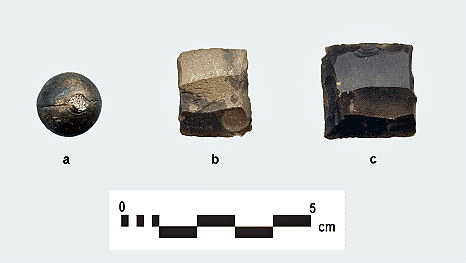Fort York, considered to be the birthplace of Toronto, contains the best collection of War of 1812 era buildings still standing on their original foundations. These are contained in Fort York National Historic Site, the largest urban archaeological site in the City of Toronto. Until recently, most of the excavations took place under the direction of city archaeologists in advance of major conservation work on the aging buildings, and the construction of new buildings to enhance the historical landscape. ASI, in association with Strata Consulting, has been involved in the revitalization programme since 2009, when it was announced that a new visitors centre would be constructed and the Garrison Common landscape would be restored. In 2011, a special project to relocate the Lieutenant-Governor’s residence destroyed during the Battle of York in April 1813 was undertaken as part of a documentary to commemorate the War of 1812.
Musket Ball (a)
These lead balls were the main form of ammunition for armies until the mid-nineteenth century. They were made by pouring molten lead into a mould. The moulding produced a sprue that then had to be cut to make the ball more round. The manufacturing process, including the mould seam and the scar where the sprue was cut, left very visible marks on this musket ball.

Pistol Gunflint (b)
This small, thin gunflint was used in the firing mechanism for a pistol. Upon the trigger being pulled, the locking mechanism would release the gunflint which would then scrape against the frizzen plate. The scraping would produce sparks that would ignite the powder and fire the weapon.
Brown Bess Gunflint (c)
This large, robust gunflint would have probably been used on a British Brown Bess musket. The firing process was similar to all flintlock mechanisms. The dark bluish-gray and the spotted medium gray colour of these two gunflints suggest that they were of British origin, having been quarried at Brandon quarries northeast of London, England.









